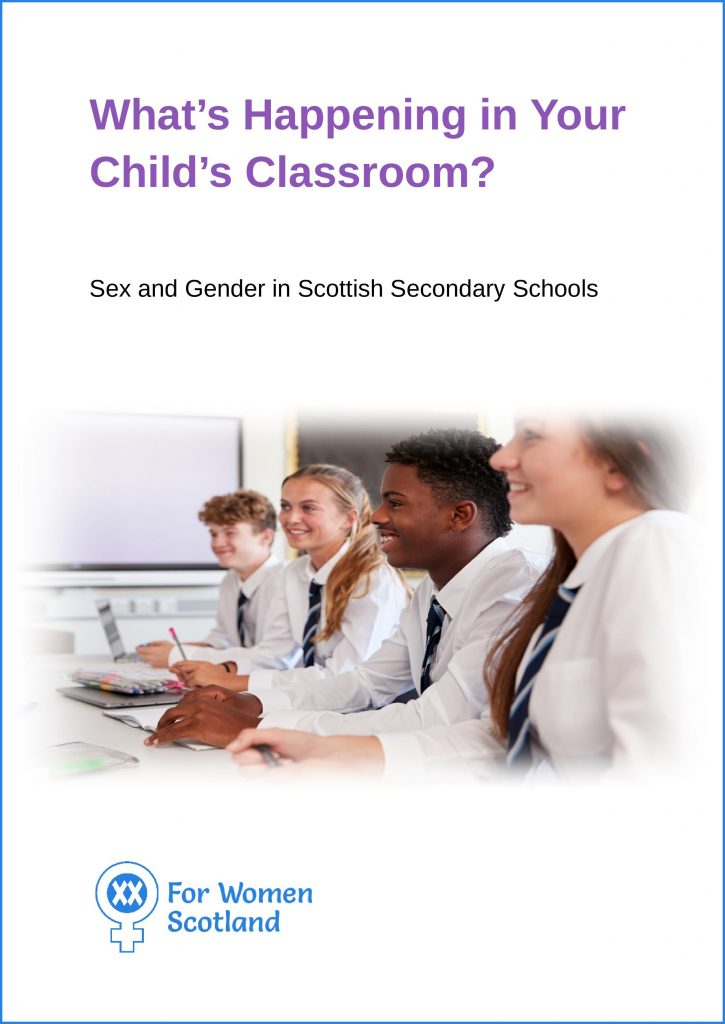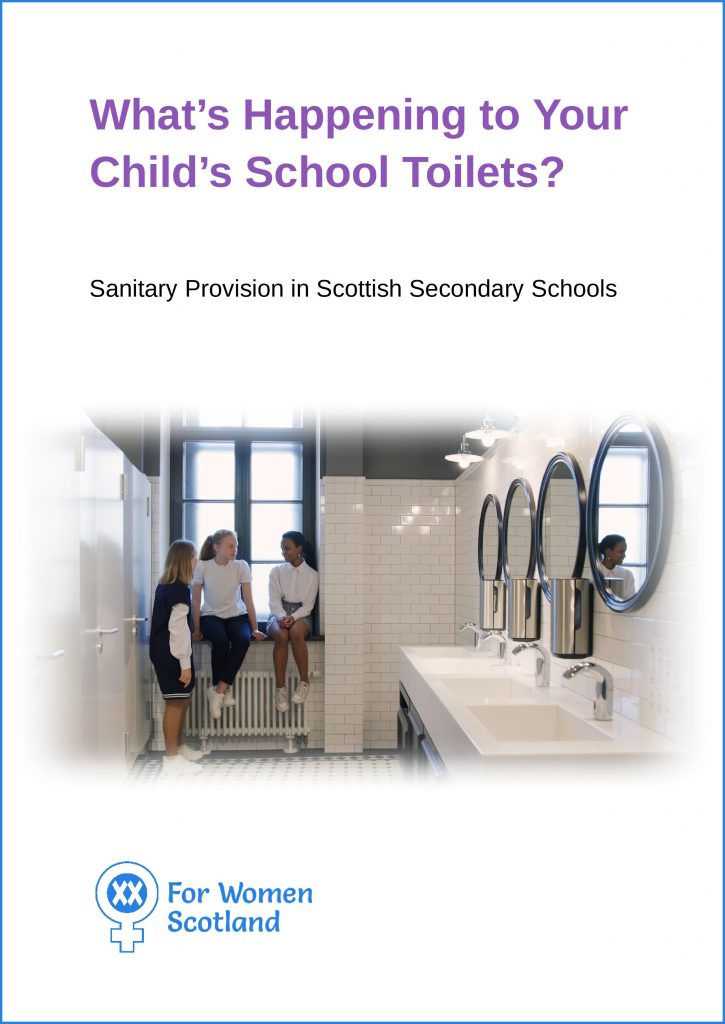What’s Happening in Your Child’s School?

Report 1: What’s Happening in Your Child’s Classroom?

Summary
The number of children presenting with gender distress in Scotland has soared over the last decade, particularly since 2017 when many schools adopted transgender guidance written by the activist organisation LGBT Youth Scotland, and which was later updated by the Scottish Government. This guidance urges teachers to affirm a gender-distressed child in their self-determined “gender identity” and facilitate a “social transition” by agreeing to use a different name or pronouns when referring to the child, and allow access to the opposite-sex toilets and changing rooms if that is where they “feel most comfortable”.
The medical treatment of gender-distressed children has come under intense scrutiny over the last few years culminating in the recent publication of the Cass Review which laid bare the serious failings with the nature of affirmative practices by gender clinics. Recognising the very poor evidence base and potential harms of puberty blockers and cross-sex hormones, Scotland’s NHS subsequently suspended prescriptions for patients under the age of 18. The evidence shows that a transgender identity, if not affirmed, is transient in the majority of children and safeguarding and additional medical issues can be overlooked or confused when there is a focus on gender.
Cass states that affirming and facilitating a social transition is an active medical intervention which “may have significant effects on the child or young person in terms of their psychological functioning” and should only be undertaken under certain strict criteria including a diagnosis of gender dysphoria and with parental involvement and clinical supervision. It should never be a matter on which a school alone might act unilaterally, however well meaning its views on the wellbeing of the child.
We replicated the Freedom of Information question set used by Policy Exchange in the publication “Asleep at the Wheel: An Examination of Gender and Safeguarding in Schools” to assess how well Scottish local authority run secondary schools are protecting gender distressed children and their classmates, as well as what is taught on sex and gender. Responses were received from 98% of schools (351 from a total of 359) and analysis shows that almost all secondary schools are disregarding basic child protection protocols regarding gender distressed children and their peers:
Self-id
- 95% of secondary schools operate policies of gender self-identification.
Who is informed?
- Only 4% of secondary schools are reliably informing parents as soon as a child discloses feelings of gender distress.
- 87% of secondary schools did not say they would inform a child protection lead or medical practitioner when a child discloses gender distress.
- 15% of secondary schools would seek advice from third-sector organisations such as LGBT Youth Scotland but would not inform parents or professionals.
Single-sex
- At least 60% of secondary schools are not maintaining single-sex toilets and 55% are not maintaining single-sex changing rooms.
- 54% of secondary schools are allowing children to participate in sports of the opposite sex, with 16% offering mixed-sex sports only.
Pronouns
- 86% of secondary schools are requiring or encouraging other children to affirm a gender-distressed child’s new identity.
What is taught?
- 89% of secondary schools are teaching that people have a gender identity that may be different from their sex.
- 7% are teaching that some people or children may be born in the wrong body.
- 37% are teaching pupils that a person who self identifies as a man or a woman should be treated as such in all circumstances, even if this does not match their biological sex.
- 75% of schools use external providers for resources on gender identity. Most frequently cited are RSHP.scot, LGBT Youth Scotland and Time for Inclusive Education.
There is a misconception that the occasional headlines in the press about children socially transitioned without parents knowledge or boys causing upset by using the girls’ toilets represent isolated incidents, and that such practices are only happening in a small number of schools. This report conclusively disproves that theory.
The transgender guidance provided by the Scottish Government clearly has a significant influence on decisions made by schools which, by and large, unquestioningly follow its advice, even when it is out of date, unlawful and supports an unscientific contested belief system that has more in common with religious studies than it does with biology lessons.
External agencies also exert an increasing influence over school policies on how best to treat the influx of children who say they are transgender and these organisations, without exception, advise teachers to take an affirming approach no matter how young the child. These include Stonewall, Scottish Trans, Time for Inclusive Education (TIE) and most ubiquitous of all, LGBT Youth Scotland which, despite being a registered lobbying group working towards explicitly political aims, has a central role in writing Scottish Government guidance for schools, training teachers, providing anti-bullying advice, embedding LGBT inclusive education across the curriculum, and an extensive charter scheme that rewards schools for rewriting policies to align with the organisation’s aims of prioritising the highly contested notion of a person’s self-determined “gender identity” over their sex.
Gender ideology is deeply embedded in schools, but it needn’t be. Schools must take their cue from the well-evidenced clinical Cass Report. The Scottish Government transgender guidance is non-statutory and can be safely ignored, as it should be. Lobby groups, no matter who they are, have no place in schools where there is a duty to present unbiased factual information and they must be immediately removed. When activists LGBT Youth Scotland are openly opposing the evidence of Cass and calling for known harmful drugs to be prescribed to children on demand there should be no doubt, and no delay.
Report 2: What’s Happening to Your Child’s School Toilets?

Summary
While analysing Freedom of Information (FOI) responses for our previous report: “What’s Happening in Your Child’s Classroom?”, it quickly became clear there was an issue with maintaining single-sex toilets for pupils, not only by allowing children to use those provided for the opposite sex but in the demise of single-sex facilities altogether, with several schools now only providing mixed-sex toilets.
We undertook a new FOI exercise to assess how many local authority run secondary schools provide mixed-sex toilets for pupils, either on their own, or in combination with single-sex toilets.
A decade ago there was no need to clarify the layout of toilets in schools or ask who could use which toilet. However, in recent years the influence of transgender lobbying groups such as LGBT Youth Scotland has been profound, with many schools replacing urinals with WCs in boys’ toilet facilities during school refurbishment projects as a way to ease transition to what is termed “gender-neutral” provision, which in reality, simply means mixed-sex provision where boys and girls share toilet cubicles and hand washing areas.
The applicable legislation for toilet provision is the School Premises (General Requirements and Standards) (Scotland) Regulations 1967 which mandates that schools provide a minimum number of sanitary appliances, dependent on the school roll, and half the accommodation shall be for girls and the other half for boys (where a certain proportion of the appliances shall be urinals). The Scottish Government conducted a public consultation in 2017 on proposals to change the Regulations to allow more flexibility in provision and for urinals to be replaced with toilets. However, the analysis report showed mixed responses from both organisations and individuals, and no further action was taken by the Government. The 1967 Act remains in place. Our FOI request incorporated questions on the number and type of appliances in both single-sex and mixed-sex toilets to determine whether schools were complying with the statutory legislation.
243 schools, 68% of the total of 359 local authority run secondary schools (excluding additional support needs schools), responded to the FOI requests and analysis shows that almost all secondary schools are disregarding the School Premises Regulations and failing in their non-harassment obligations under the Equality Act 2010. Key findings include:
Type of sanitary provision
- 79% of secondary schools provide single-sex toilets only.
- 5% of secondary schools provide mixed-sex toilets only.
- 16% of secondary schools provide a combination of single-sex and mixed-sex toilets.
Compliance with the School Premises Regulations: single-sex
- 52% of schools providing single-sex toilets for girls meet the minimum number of toilets required.
- 59% of schools providing single-sex toilets for boys meet the minimum number of appliances required, but only 10% of this number provide the correct ratio of WCs to urinals.
- Only 13 schools comply with the Regulations for single-sex provisions for both male and female pupils, dropping to just 3 schools that uphold the single-sex provisions by not permitting pupils to use the opposite sex toilets. These schools are Islay High School and Tarbert High School in Argyll and Bute, and Castlebay School in the Western Isles.
- 60% of secondary schools allow girls who identify as transgender to use the boys’ toilets but only 5% of schools provide sanitary bins in the boys’ toilets.
Compliance with the School Premises Regulations: mixed-sex
- None of the 11 secondary schools providing only mixed-sex toilets comply with the Regulations as they fail to provide the required number of urinals for boys.
- 38 of the 39 secondary schools providing a combination of single-sex and mixed-sex toilets do not comply with the Regulations in terms of minimum numbers of appliances and correct ratio of WCs to urinals for boys. The one remaining school, Lochgilphead High School, meets the Regulations in full and provides an additional block of 3 cubicles for any pupil to use. This is still not lawful under the Equality Act.
Gender ideology is deeply embedded in schools and is oblivious to the harms it causes children, particularly girls. In almost every newspaper article that reports on the outrage caused by a school’s decision to install mixed-sex facilities the distress of girls is clear, and we frequently receive requests for help and advice from parents whose daughters are avoiding the mixed-sex toilets, not drinking, or have been victims of boys exposing themselves. The increased risk of sexual harassment in mixed-sex toilets is obvious, and schools are woefully neglecting their safeguarding and Equality Act duties to prevent and avoid such incidents.
A legal opinion provided by senior counsel Aidan O’Neill KC advises that enforcement of any breach of a local authority’s obligation to provide separate single-sex toilets for pupils is best pursued via the Equality Act (rather than on those set out in the School Premises Regulations) on their breach of non-harassment obligations related to sex. This is in the interests of respect for privacy, preserving decency, preventing trauma and/or ensuring health and safety particularly of girls, and to avoid creating what girls in particular might perceive and experience as an intimidating, hostile, degrading, humiliating or offensive environment for them. The Equality Act recognises the more serious nature of harassment and remedies may include compensation for injury to feelings and aggravated damages.
Ideally, the Scottish Government should step in before it reaches this stage by updating the transgender guidance to schools and advising local authorities on the importance of ensuring existing legislation and children’s rights are upheld. Two separate legal opinions and the latest guidance from the Equality and Human Rights Commission have indicated that maintaining single-sex toilet provision with additional single-user unisex toilets would ensure there is suitable accommodation for children who identify as transgender, without breaching the law or the rights of other children.
